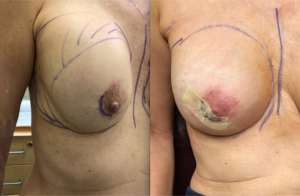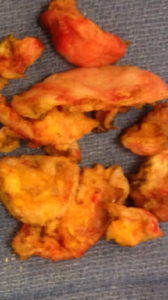CAPSULE – SCAR TISSUE REMOVAL
Posted On: July 10, 2019 Author: The Office of Dr. Stuart Linder Posted In: Breast Revision, Uncategorized
CAPSULECTOMY
Patients present for capsular contracture, severe, every week in my Beverly Hills practice. What exactly is the capsule that forms around an implant? Any time a prosthetic device is placed in the body, i.e., hydraulic shunts into the brain, heart valves, aortic valves, mitral valves, prosthetic hips or any other form of internal foreign material, the body creates a capsule within one month.
The composition of a capsule includes collagen, blood vessels, and fibroblast. Scar tissue formation around internal appliances and implantable devices is common and usual. A capsule will form a internal protective cover on any foreign object, including a splinter in the finger. When a capsule becomes thickened due to increase in collagen or myofibroblastic contraction, hardening can occur, leading to capsular contracture of the breast. Baker I classification is soft, Baker II is palpable, Baker III is palpable and hard, Baker IV is palpable, hard and distortion and coldness to the breast occurs.
The photograph shows portions of capsule removed during a recent capsulectomy. Notice the thickness of the capsule. The capsule can vary in color, from yellow to whitish, pure white. This is associated with silicone calcifications. It can also be associated with protein within the capsule and can be an important indicator of an acute versus chronic rupture of the silicone implant.
Capsules can present with hardening and calcifications and plaque formation called silicone granulomata which may be associated with a ruptured silicone implant after a long period of time. Capsule tissue should always be sent to Pathology for diagnostic purposes in order to determine malignancy. Malignancy can occur within a capsule. Patients especially with seromas within the breast or chronic seromas should be tested, the fluid, for lymphoblastic cancer. It is important to realize that capsules are normal. They do form and will form in any antigen, including a breast implant. What becomes pathological is when it becomes thick, hard and contracts which may again lead to severe disfigurement and pain.
Case Study
Total Capsulectomy of the Right Breast

Just over one year ago, the 54-year-old female presented to the left underwent a breast augmentation procedure that was performed by a different surgeon. She came to my office and requested for her right breast implant to be removed and replaced because she was unhappy with the disfigured result she ended up with originally.
During the consultation, it was apparent that she had capsular contracture, which is scar tissue that forms around the breast implant causing the breast to harden and create this deformity (see in the pre-op photo to the left). After listening to her goals and agreeing on the expectation, we scheduled a surgery date.
During the surgical procedure, I performed a total capsulectomy and replaced the old implant with 315 cc SRX full profile silicone gel implant. The post-op photo is only one day after surgery, but you can see her breast is already nice in appearance and she is very pleased with her shape and fullness.
To schedule your consultation with Dr. Linder and learn more about breast revision surgery, call our Beverly Hills office at (310) 275-4513 or fill out our online contact form today.
